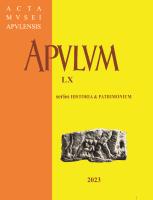HABITATUL ȘI ALIMENTAȚIA TRADIȚIONALĂ DIN ZONA PLATOULUI GHEȚARI, ȚARA MOȚILOR (JUD. ALBA)
Traditional Habitat and Food in the Area of the Ghețari Plateau, Țara Moților (Alba County)
Author(s): Adriana ȚuțuianuSubject(s): Anthropology, Cultural history, Ethnohistory, Cultural Anthropology / Ethnology
Published by: Muzeul National al Unirii Alba Iulia
Keywords: Ghețari plateau; village; household; houses; outbuildings; traditional food;
Summary/Abstract: Situated at 1100 m altitude and framed by the rivers Gârda Seacă and Valea Ordâcușei, the Ghețari plateau appears in tourist guides, mainly thanks to the famous cave called Ghețarul de la Scărișoara. The villages of Ghețari, Biharia, Dealu Frumos, Dealu Ordâcușei, Gârda Seacă, Hănășești, Huzărești, Izvoarele, Munună, Ocoale, Plai, Pliști, Scoarța, Snideși, Sucești belong to the commune of Gârda de Sus. The area of the settlements with scattered households, called villages – ”crânguri”, is the mountainous massif of the Apuseni Mountains, and includes the villages of Țara Moților (the upper basin of the Arieș Mare, from Bistra upwards), Țara Abrudului (the gold-bearing quadrangle whose sides run between Baia de Arieș, Abrud, Baia de Criș and Săcărâmb), Mocănimea (the middle basin of the Arieș Mic). The first types of seasonal shelters – ”mutăturile” – appeared on the mixed farming properties in the groves that often mark out the terraced shoulders of the valley sides, the small hanging basins and the fragments of platforms. The real meaning of the term is to move shepherds and animals for grazing and wintering. The architecture is simple, like most of the houses in the Apuseni Mountains, based on the construction system of joists joined at the corners and with a rafter roof covered with straw or shingles. Recently, however, due to changes in the living conditions of the local people, there has been a trend towards an increase in the number of rooms in new houses, the starting point being the three-room house, rising to five or six. It can be seen in most new houses how the creativity of the craftsmen has diminished both in terms of reasonable aesthetic solutions and in terms of correct functional and economic solutions. The basic foods were bread and polenta; consumption of polenta was much higher until 1990 when it was made every day because corn was always cheaper than wheat and polenta was prepared faster and easier than bread. Oil was made only from flax and hemp seed, but in tiny quantities, and was consumed only during the fasting season. Highland households had more dairy products available, commonly used either at the morning meal, or at supper, but in this case for five months of the year the whole family was dependent on milk given by 1-2 cows or 3-4 sheep, but even this was so little that they had to curdle it. Meat consumption was largely regulated, in most households, by traditional seasonal slaughtering, some linked to the cycles of the most important holidays: pigs for the winter cycle, lambs for the spring cycle, poultry in summer, cattle all year round.
Journal: Apulum
- Issue Year: 60/2023
- Issue No: 1
- Page Range: 265-294
- Page Count: 30
- Language: Romanian
- Content File-PDF

